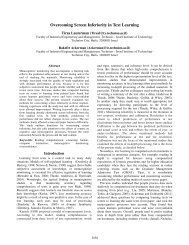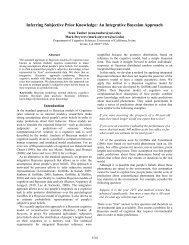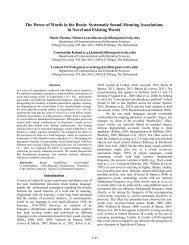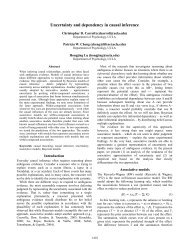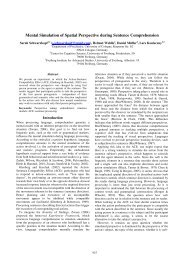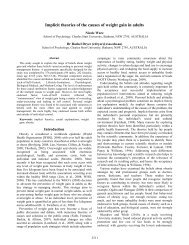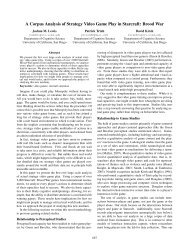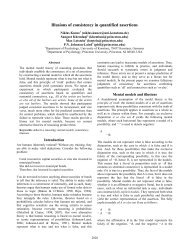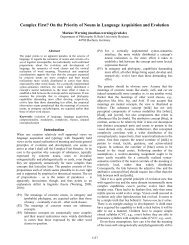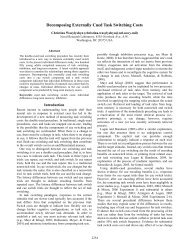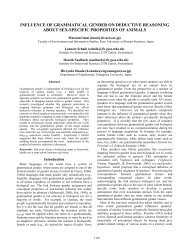A Text Corpus Analysis Approach to the Conjunction Fallacy
A Text Corpus Analysis Approach to the Conjunction Fallacy
A Text Corpus Analysis Approach to the Conjunction Fallacy
Create successful ePaper yourself
Turn your PDF publications into a flip-book with our unique Google optimized e-Paper software.
A <strong>Text</strong> <strong>Corpus</strong> <strong>Analysis</strong> <strong>Approach</strong> <strong>to</strong> <strong>the</strong> <strong>Conjunction</strong> <strong>Fallacy</strong><br />
YuichiroWajima (wajima@nm.hum.titech.ac.jp)<br />
Kuninori Nakamura (knaka@ky.hum.titech.ac.jp)<br />
AsukaTerai (asuka@nm.hum.titech.ac.jp)<br />
KimihikoYamagishi (kimihiko@ky.hum.titech.ac.jp)<br />
Masanori Nakagawa (nakagawa@nm.hum.titech.ac.jp)<br />
Graduate School of Decision Science Technology, Tokyo Institute of Technology<br />
2-12-1, Ookayama, Meguro-Ku, Tokyo, 152-8552, Japan<br />
Abstract<br />
This study aims<strong>to</strong> explain <strong>the</strong>conjunction fallacy<br />
(Tversky&Kahneman, 1983) in terms of degree of<br />
confirmation (Crupi, Ten<strong>to</strong>ri, & Gonzalez,2007) by<br />
employing corpus data analysis. To accomplish this,<br />
wecalculated indexes of <strong>the</strong> degrees of confirmation from<strong>the</strong><br />
British National <strong>Corpus</strong> and fitted <strong>the</strong>m <strong>to</strong> dataof <strong>the</strong> previous<br />
study (Shafir et al., 1990). The resultsshow that a major index<br />
of <strong>the</strong> degree of confirmation(Crupi et al., 2007) can<br />
significantly predict <strong>the</strong>conjunction fallacy, indicating a<br />
relationship between<strong>the</strong> conjunction fallacy and degree of<br />
confirmationas well as<strong>the</strong> importance of corpus data <strong>to</strong><br />
explain biasesin judgment.<br />
Keywords:<strong>Conjunction</strong> <strong>Fallacy</strong>, Degree of Confirmation,<br />
<strong>Corpus</strong> Data <strong>Analysis</strong><br />
Introduction<br />
The conjunction fallacy (Tversky&Kahneman, 1983) is<br />
one of <strong>the</strong> most famous violations of <strong>the</strong> normative axiom of<br />
probability. A representative experiment of this<br />
phenomenon asked participants <strong>to</strong> think about Linda as she<br />
is described in <strong>the</strong> following sentences:<br />
Linda is 31 years old, single, outspoken, and very<br />
bright.She majored in philosophy. As a student, she<br />
was deeplyconcerned with issues of discrimination and<br />
social justice,and also participated in antinuclear<br />
demonstrations.<br />
Then, participants were required <strong>to</strong> rank various<br />
statements about Linda “by <strong>the</strong>ir probability.” Two of<br />
<strong>the</strong>sestatements were“B” and “B and F”:<br />
(B) Linda is a bank teller.<br />
(B and F) Linda is a bank teller and is active in <strong>the</strong><br />
feministmovement.<br />
In Tversky and Kahneman (1983), 85% of <strong>the</strong> participants<br />
ranked“B and F” as more probable than “B.” This judgment<br />
is in apparent violationof <strong>the</strong> conjunction law Pr(X and<br />
Y|Z)
P(<br />
h)<br />
P(<br />
d | h)<br />
P ( h | d)<br />
=<br />
(1)<br />
P(<br />
d)<br />
As you can see, Bayes’ <strong>the</strong>orem defines a relationship<br />
between <strong>the</strong> prior belief (P(h)) and <strong>the</strong> posterior belief. In<br />
this vein, whe<strong>the</strong>r <strong>the</strong> data support <strong>the</strong> hypo<strong>the</strong>sis or not can<br />
be represented by <strong>the</strong> difference between <strong>the</strong> prior and<br />
posterior probabilities; when <strong>the</strong> posterior probability is<br />
higher than <strong>the</strong> prior probability, <strong>the</strong> data support <strong>the</strong><br />
hypo<strong>the</strong>sis, and when not, <strong>the</strong>y disconfirmit. Thus, degree of<br />
confirmation c(h, d) can be expressed as shown in (2):<br />
⎧><br />
0,<br />
P(<br />
h | d)<br />
> P(<br />
h)<br />
⎪<br />
c(<br />
h,<br />
d)<br />
⎨=<br />
0,<br />
P(<br />
h | d)<br />
= P(<br />
h)<br />
(2)<br />
⎪<br />
⎩<<br />
0,<br />
P(<br />
h | d)<br />
< P(<br />
h)<br />
We must mention that it is possible <strong>to</strong> define many kinds<br />
of criteria that can satisfy <strong>the</strong> equation in (2).This equation<br />
solely proposes that <strong>the</strong> data support <strong>the</strong> hypo<strong>the</strong>sis if <strong>the</strong><br />
posterior probability is higher than <strong>the</strong> prior probability;it<br />
does not determine <strong>the</strong> degree of support. In fact, <strong>the</strong>re are<br />
various types of criteria for degree of confirmation that can<br />
satisfy (2). Table 2 shows representative indexes of <strong>the</strong><br />
degrees of confirmation (also see Eells&Fitelson, 2002;<br />
Fitelson, 1999; Ten<strong>to</strong>ri, Crupi, Bonini, &Fitelson, 2007).<br />
Ten<strong>to</strong>ri, Crupi, Bonini, and Fitelson (2007) report on<br />
experiments that compared <strong>the</strong> adequacy of several such<br />
measures as descriptions of confirmation judgmentin a<br />
probabilistic context. In <strong>the</strong> experiments, <strong>the</strong>y showed<br />
participants two opaque urns that contained different<br />
numbers of white and black balls, and <strong>the</strong> numbers of each<br />
were known <strong>to</strong> <strong>the</strong> participants. Then, participants randomly<br />
chose one of <strong>the</strong> two urns by a coin <strong>to</strong>ss, but <strong>the</strong> outcome of<br />
<strong>the</strong> coin <strong>to</strong>ss was unknown <strong>to</strong> <strong>the</strong>m. After selecting an urn in<br />
this way, <strong>the</strong> participants were required <strong>to</strong> draw a ball and<br />
estimate <strong>the</strong> impact of <strong>the</strong> results of <strong>the</strong> ball drawing with<br />
various types of response scales in 10 successive trials.<br />
Based on <strong>the</strong> number of balls that <strong>the</strong> two urns contained,<br />
<strong>the</strong>participants calculated various types of <strong>the</strong> confirmation<br />
indexes and compared <strong>the</strong>m <strong>to</strong> <strong>the</strong> estimated degree of<br />
confirmation. Results showed that some of <strong>the</strong> confirmation<br />
indexes significantly correlate <strong>to</strong> <strong>the</strong> participants’ responses,<br />
indicating that human hypo<strong>the</strong>sis confirmation follows<br />
rational thought as <strong>the</strong> Bayesian agent is assumed <strong>to</strong> do so.<br />
Crupi, Fitelson, and Ten<strong>to</strong>ri (2008) suggest that <strong>the</strong><br />
conjunction fallacy can be explained in terms of <strong>the</strong><br />
Bayesian hypo<strong>the</strong>sis confirmation. They insist that<br />
participants in <strong>the</strong> conjunction fallacy experiments do not<br />
consider probabilities for conjunctions or each proposition<br />
that composes <strong>the</strong> conjunction. Ra<strong>the</strong>r, <strong>the</strong>y appear <strong>to</strong><br />
estimate how <strong>the</strong> description supports <strong>the</strong> conjunction as<br />
data. Based on this idea, Crupi, Fitelson, and Ten<strong>to</strong>ri specify<br />
a condition in which <strong>the</strong> degree of confirmation for <strong>the</strong><br />
conjunction becomes larger than that for each proposition.<br />
This condition is shown in (3):<br />
c ( h1,<br />
e)<br />
≤0<br />
and c(<br />
h2,<br />
e | h1)<br />
≥1<br />
,<br />
<strong>the</strong>n c(<br />
h & h | e)<br />
≥c(<br />
h , e)<br />
1<br />
2<br />
Ano<strong>the</strong>r important feature of <strong>the</strong> condition is its<br />
robustness; Crupi et al. (2008) also show that this condition<br />
holds any confirmation measures, including D, R, L, C, S,<br />
and Z (table 1). In o<strong>the</strong>r words, each of <strong>the</strong>se confirmation<br />
measures can explain <strong>the</strong> conjunction fallacy if people’s<br />
probability judgment about conjunction depends on <strong>the</strong><br />
degree of confirmation. Thus, not only whe<strong>the</strong>r <strong>the</strong> degree<br />
of confirmation but also what measure can explain <strong>the</strong><br />
conjunction fallacy is an interesting empirical question.<br />
Table 1.variation of <strong>the</strong> degree of conformation<br />
D(A,E) = p(A | E) − p(A)<br />
C(A,E) = p(A & E) − p(A) × p(E)<br />
S(A,E) = p(A | E) − p(A |¬E)<br />
⎧ p(A | E) − p(A)<br />
⎪ 1− p(A)<br />
Z(A,E) = ⎨<br />
⎪<br />
p(A | E) − p(A)<br />
⎩ ⎪ p(A)<br />
1<br />
(3)<br />
(Carnap, 1950; Eells, 1982)<br />
(Carnap, 1950)<br />
(Christensen, 1999; Joyce, 1999)<br />
if p(A | E) ≥ p(A)<br />
o<strong>the</strong>rwise<br />
(Crupi, Ten<strong>to</strong>ri& Gonzalez, 2007)<br />
However, one methodological problem of Crupi et al.’s<br />
(2007) explanation lies in how <strong>to</strong> determine probabilities<br />
related <strong>to</strong> <strong>the</strong> conjunction. All <strong>the</strong> confirmation measures,<br />
although <strong>the</strong>y are not probabilities <strong>the</strong>mselves, require<br />
values of probabilities for h1, h2, and e. In <strong>the</strong> experimental<br />
paradigm of <strong>the</strong> conjunction fallacy, this requirement is very<br />
difficult <strong>to</strong> fill, because <strong>the</strong> conjunction fallacy demonstrates<br />
that peoples’ probability judgments for <strong>the</strong>se components<br />
deviate from <strong>the</strong> normative principle. In o<strong>the</strong>r words, we<br />
cannot define <strong>the</strong> values of <strong>the</strong> probabilities required <strong>to</strong><br />
calculate <strong>the</strong> degree of confirmation from probability<br />
judgment data. Ra<strong>the</strong>r, it is desirable <strong>to</strong> define <strong>the</strong><br />
probability values based on objective data, not on subjective<br />
probability judgments.<br />
Statistical corpus analysis<br />
Statistical corpus analysis can address <strong>the</strong> above problems.<br />
Statistical corpora containlarge amounts of sentences that<br />
are collected from natural language communication such as<br />
literature (British National <strong>Corpus</strong>) or newspapers<br />
(Mainichi-shinbun database) and enableresearchers <strong>to</strong><br />
access information on word frequencies or co-occurrences.<br />
1528
These databases can be considered as reflecting everyday<br />
verbal communication and have assumed <strong>to</strong> be<br />
substitutionsfor human memory structure (e.g.,<br />
Steyvers&Tenenbaum, 2006; Stewart, Chater, & Brown,<br />
2006).<br />
Recently, <strong>the</strong> number of studiesthatattempt <strong>to</strong> describe<br />
human reasoning with corpus statistical data has been<br />
increasing (e.g., Sakamo<strong>to</strong> & Nakagawa, 2007; Stewart,<br />
Chater, & Brown, 2006; Terai & Nakagawa, 2007; Utsumi,<br />
2010).These studies assume that frequencies of appearance<br />
or co-occurrence among words reflect word affinities or <strong>the</strong><br />
strength of associative connections among words and<br />
substitute<strong>the</strong>m as parameters for statistical models. For<br />
example, Sakamo<strong>to</strong> and Nakagawa (2007) hypo<strong>the</strong>sized<br />
cognitive processes of category-based induction (e.g.,<br />
Osherson et al., 1990) as classification based on associations<br />
between premises and conclusions, and employed<br />
probabilities for co-occurrence among <strong>the</strong> words that are<br />
contained in <strong>the</strong> premise and conclusion. The results of <strong>the</strong>ir<br />
study supported <strong>the</strong> hypo<strong>the</strong>sis, suggesting that probabilistic<br />
properties of corpus data reflect basic knowledge of human<br />
reasoning.<br />
Additionally, applying <strong>the</strong> corpus data analysis approach<br />
<strong>to</strong> <strong>the</strong> issue of <strong>the</strong> conjunction fallacy appears <strong>to</strong> be very<br />
natural upon inspection of<strong>the</strong>experimental procedure. In <strong>the</strong><br />
typical experiment, participants read sentences that describe<br />
features of characters, such as “outspoken” or<br />
“philosophical,” and are required <strong>to</strong> rank alternatives (e.g.,<br />
“bank teller,”“feminist”) by <strong>the</strong>ir probability. In this<br />
situation, it is natural <strong>to</strong> assume that participants access <strong>the</strong>ir<br />
memory <strong>to</strong> solve <strong>the</strong> task and that this assessment <strong>to</strong> <strong>the</strong>ir<br />
memory affects <strong>the</strong>ir probability judgment foreach<br />
proposition. If corpus data reflect memory strength of <strong>the</strong><br />
words contained in <strong>the</strong> stimulus sentences, we can employ<br />
<strong>the</strong> corpus data <strong>to</strong> test Crupi et al.’s (2007) hypo<strong>the</strong>sis.<br />
The purpose of this study<br />
From <strong>the</strong> above discussion, we derive <strong>the</strong> following<br />
hypo<strong>the</strong>sis about <strong>the</strong> conjunction fallacy; in <strong>the</strong><br />
experimental procedure of <strong>the</strong> conjunction<br />
fallacy,participants estimate <strong>the</strong> degree of confirmation for<br />
<strong>the</strong> conjunction by assessing <strong>the</strong>ir memory strength. To test<br />
this hypo<strong>the</strong>sis, we report two studies. The first reanalyzed<br />
<strong>the</strong> data of Shafir, Smith, and Osherson (1990) that are<br />
adequate <strong>to</strong> test our approach. The second collected new<br />
data from Japanese participants. In both studies, we<br />
calculate parameters of <strong>the</strong> degrees of probability with any<br />
given assumptionusinga language corpus and examine <strong>the</strong><br />
idea that <strong>the</strong> conjunction fallacy occurs as a result of <strong>the</strong><br />
Bayesian updating of degree of <strong>the</strong> confirmation.<br />
Study 1: Reanalysis of Shafir et al. (1990)<br />
The purpose of Study 1 is <strong>to</strong> test our hypo<strong>the</strong>sis by<br />
reanalyzing <strong>the</strong> data of Shafir et al (1990). Shafir et al<br />
(1990) required participants <strong>to</strong> rate probabilities of<br />
occurrence of <strong>the</strong> contents of both 15 conditional sentences<br />
and combinations of propositions. The sentences that were<br />
judged by participants had <strong>the</strong> frame: Every single in <strong>the</strong><br />
group is . For example, <strong>the</strong>y employed stimulus sentences<br />
such as those below in order <strong>to</strong> consider<strong>the</strong> conjunction<br />
fallacy by comparing single and conjunctive condition texts:<br />
Single condition:<br />
“Every single lawyer in <strong>the</strong> group is conservative.”<br />
Conjunctive condition:<br />
“Every single labor-union lawyer in <strong>the</strong> group is<br />
conservative.”<br />
In this case, <strong>the</strong> data (e) is “conservative” and single<br />
hypo<strong>the</strong>sis (h1) and conjunctive hypo<strong>the</strong>sis (h1&h2) are<br />
“lawyer” and “labor-union lawyer,” respectively. The<br />
participants were request <strong>to</strong> rate <strong>the</strong> probability of each<br />
conditions.They calculated <strong>the</strong> degree of fallacy by<br />
subtracting <strong>the</strong> probability of <strong>the</strong> single condition from <strong>the</strong><br />
probability of <strong>the</strong> conjunctive condition.<br />
In Shafir et al.’s (1990) experiment, <strong>the</strong> attributes of <strong>the</strong><br />
data (e) and hypo<strong>the</strong>sis (h1, h2) are comprised of one word.<br />
In such experiments on <strong>the</strong> conjunction fallacy using stimuli,<br />
it is natural <strong>to</strong> assume that participants’ judgments are<br />
dependent on <strong>the</strong> characteristics and relationships of each<br />
word; <strong>the</strong>refore, it is very appropriate <strong>to</strong> consider <strong>the</strong><br />
connection of language statistics and <strong>the</strong> conjunction fallacy.<br />
Thus, we selected it as <strong>the</strong> subject of analysis of this study.<br />
This study compares <strong>the</strong> degree of conformation that was<br />
calculatedform <strong>the</strong> occurrence and co-occurrence<br />
probabilities of words in a language corpus and <strong>the</strong> results<br />
of <strong>the</strong> conjunction fallacy experiment performed by Shafir<br />
et al. (1990).<br />
We use <strong>the</strong> British National <strong>Corpus</strong> (BNC) as language<br />
statistical data. The BNC, launched in 1991, is <strong>the</strong> world’s<br />
largest English corpus, consisting of approximately 100<br />
million words including both British written and colloquial<br />
words, and is designed <strong>to</strong> represent modern British English<br />
as broadly as possible. It consists of approximately 90%<br />
written words and 10% colloquial words. Data <strong>to</strong> be added<br />
are selected based on statistical value by area of <strong>the</strong> number<br />
of annual publications in <strong>the</strong> UK. We decided <strong>to</strong> use<strong>the</strong><br />
BNC as <strong>the</strong> original data source for calculating <strong>the</strong> degree of<br />
probability for <strong>the</strong> study because it contains enough data,<br />
and <strong>the</strong> date on which <strong>the</strong> original BNC texts were prepared<br />
is close <strong>to</strong>, or prior <strong>to</strong>, <strong>the</strong> date Shafir et al.’s (1990)<br />
experiment was performed.<br />
1529
.35<br />
Degree of<br />
fallacy<br />
r= -.003 r= .35 r= -.003 r= .76 **<br />
-.05<br />
-.0065 D 0 -2*10 C S Z<br />
Figure 1.<strong>the</strong> result of study 1<br />
**: p
.45<br />
Degree of<br />
fallacy<br />
Degree of<br />
fallacy<br />
r= -.21 r= -.41 r= -.21 r= .64 *<br />
0<br />
-.035 D .005 -2.8*10 C S Z<br />
-6<br />
0 -.035 .005 -1.15 .05<br />
.45<br />
r= -.13 r= -.10 r= -.13 r= .46 +<br />
0<br />
-.014 D .001 -5.0*10 C S Z<br />
-5<br />
1.0*10 -5<br />
-.014 .001 -1.15 .40<br />
*: p
References<br />
British National <strong>Corpus</strong> (BNC)http://www.natcorp.ox.ac.uk/<br />
Carnap, R. (1950). Logical foundations of probability.<br />
Chicago: University of Chicago Press.<br />
Carnap, Rudolph, (1955), “Meaning and synonymy in<br />
natural languages”, Philosophical Studies, 7: 33-47.<br />
Reprinted in Carnap 1956, pp. 233-247<br />
Chase, V. M., Hertwig, R. and Gigerenzer, G. (1998),<br />
Visions of rationality, Trends in Cognitive Sciences, 2<br />
206-214.<br />
Christensen, D. (1999). Measuring confirmation.Journal of<br />
Philosophy, 96, 437- 461.<br />
Costello. J. (2008) How probability <strong>the</strong>ory explains <strong>the</strong><br />
conjunction fallacy, Journal of Behavioral Decision<br />
Making, 22, 3, 213 – 234<br />
Crupi, V., Fitelson, B., &Ten<strong>to</strong>ri, K.<br />
(2008).Probability,confirmation, and <strong>the</strong> conjunction<br />
fallacy.Thinking &Reasoning, 14, 182–199.<br />
Crupi, V., Ten<strong>to</strong>ri, K., & Gonzalez, M. (2007). On Bayesian<br />
measures of evidential support:Theoretical and<br />
empirical issues. Philosophy of Science, 74, 229 – 252.<br />
Dulany, D. E. and Hil<strong>to</strong>n, D. J. (1991), Conversational<br />
implicature, conscious representation,and <strong>the</strong><br />
conjunction fallacy.Social Cognition, 9, 85–110.<br />
Eells, E. (1982). Rational decision and causality. Cambridge,<br />
UK: Cambridge University Press.<br />
Eells, E. &Fitelson, B. (2002).Symmetries and asymmetries<br />
in evidential support.Philosophical Studies, 107, 129-<br />
142.<br />
Fiedler, K. (1988). The dependence of <strong>the</strong> conjunction<br />
fallacy on subtle linguistic fac<strong>to</strong>rs.Psychological<br />
Research, 50, 123–129.<br />
Joyce, J. (1999). The foundations of causal decision <strong>the</strong>ory.<br />
Cambridge (UK): Cambridge University Press<br />
Macdonald, R. and Gilhooly, K. (1986), More about Linda<br />
or conjunctions in context.European Journal of<br />
Cognitive Psychology, 2, 57–70.<br />
McKenzie, C. R. M., & Amin, M. B. (2002). When wrong<br />
predictions provide moresupport than right ones.<br />
Psychonomic Bulletin and Review, 9, 821-828.<br />
McKenzie, C. R. M., &Mikkelsen, L. A. (2007).A Bayesian<br />
view of covariationassessment.Cognitive Psychology, 54,<br />
33-61.<br />
McKenzie, C. R. M., &Mikkelsen, L. A. (2000).The<br />
psychological side of Hempel’sparadox of<br />
confirmation.Psychonomic Bulletin and Review, 7, 360-<br />
366.<br />
Morier, D. and Borgida, E. (1984), The conjunction fallacy:<br />
A task specific phenomenon?Personality and Social<br />
Psychology Bulletin, 10, 243–252.<br />
Osherson, D., Smith, E. E., Wilkie, O., Lopez, A., and Shar,<br />
E. (1990).Category-based induction.Psychological<br />
Review, 97(2):185-200.<br />
Politzer, G. and Noveck, I. A. (1991), Are conjunction rule<br />
violations <strong>the</strong> result ofconversational rule violations?<br />
Journal of Psycholinguistic Research, 20, 83–103.<br />
Sakamo<strong>to</strong>,K, Nakagawa, M, (2007) "Risk Context Effects in<br />
Inductive Reasoning: An Experimental and<br />
Computational Modeling Study", B. Kokinov et al.<br />
(Eds.): CONTEXT 2007, LNAI 4635, Springer-Verlag<br />
Berlin Heidelberg, pp425-438<br />
Shafir, E. B..Smith, E. E., &Osherson, D. N.<br />
(1990).Typicality andreasoning fallacies.Memory and<br />
Cognition. 18,229-239.<br />
Sides, D. Osherson, N. Bonini and R. Viale, (2002) On <strong>the</strong><br />
reality of <strong>the</strong> conjunction fallacy. Memory & Cognition,<br />
30(2):191-198.<br />
Steyvers, M., &Tenenbaum, J. B. (2005). The large scale<br />
structure of semantic networks: Statistical analyses and<br />
a model of semantic growth. Cognitive Science, 29, 41-<br />
78.<br />
Stewart, N., Chater, N., & Brown, G. D. A. (2006).Decision<br />
by sampling.Cognitive Psychology, 53, 1-26.<br />
Ten<strong>to</strong>ri, K. Bonini N. andOsherson D., (2004).The<br />
conjunction fallacy: a misunderstanding about<br />
conjunction?,Cognitive Science 28 (3), pp. 467–477.<br />
Ten<strong>to</strong>ri, Crupi, Bonini, &Osherson (2007).Probability,<br />
confirmation, and <strong>the</strong> conjunction fallacy, Thinking &<br />
Reasoning, Volume 14, Issue 2, pages 182 - 199 [3]<br />
Terai, A., Nakagawa, M. (2007). A neural network model of<br />
metaphor understanding with dynamic interaction based<br />
on a statistical language analysis: targeting a human-like<br />
model, International Journal of Neural Systems, 17(4),<br />
265-274.<br />
Tversky, A. &Kahneman, D. (1983).“Extensional<br />
vs.intuitive reasoning: The conjunction fallacy in<br />
probability judgment”, Psychological Review, 90,<br />
293–315.<br />
Utsumi, A.(2010). Computational Exploration of Metaphor<br />
Comprehension Processes Using a Semantic Space<br />
Model.Cognitive Science, DOI: 10.1111/j.1551-<br />
6709.2010.01144.x<br />
Wedell, D. H., & Moro, R. (2008). Testing boundary<br />
conditions for <strong>the</strong> conjunction fallacy: Effects of<br />
response mode, conceptual focus and problem<br />
type.Cognition, 107, 105–136.<br />
1532





